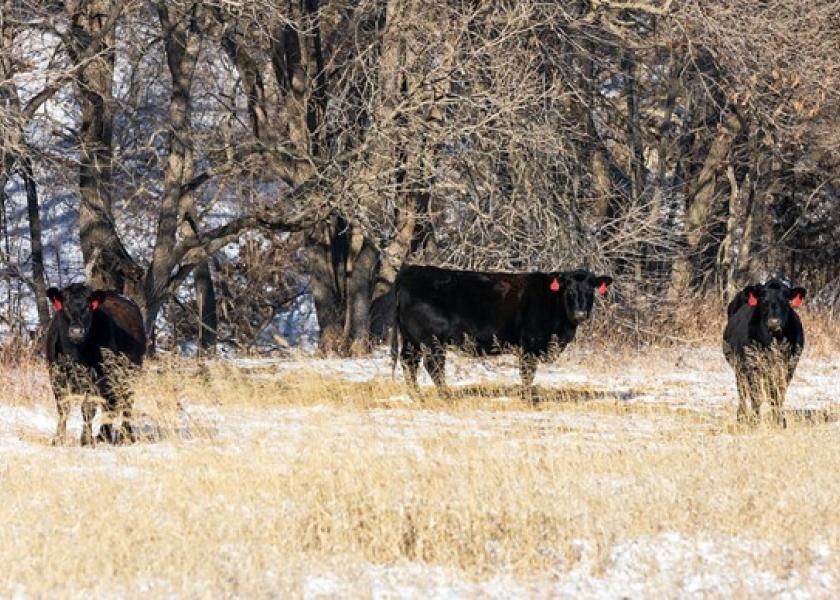“Winter cow syndrome” is a term used to describe individual cows or groups of cows that experience a significant decline in body weight and condition over the winter – sometimes becoming extremely thin, even to the point of death. The cause is usually due to a combination of factors including: physical factors of the cow(s), feed quantity and characteristics, and weather.
Cows greater than 10 years of age tend to be at higher risk for “winter cow syndrome” because some cows in this age group will have “broken mouths” or no teeth. While these cows may be able to maintain body weight when grazing growing forage, they are at risk of losing weight on dormant forage or hay.
In addition, heifers that are still growing have greater energy needs than mature cows and are also at risk for “winter cow syndrome.” Cows with other disease problems such as pneumonia, liver disease or severe parasitism (lice or intestinal worms) increase their risk for “winter cow syndrome.”
Feed quality is an important factor contributing to “winter cow syndrome.” Many extremely thin cows have a rumen full of poorly-digestible forage. Mature dormant forage or hay harvested when the plant was mature tends to have high lignin content, low protein, and low available calories.
Because high-lignin/low-protein forages have a very slow passage rate through the digestive tract, cows eating these types of forages are able to consume only about one-half to two-thirds the number of pounds of forage per day compared cows eating higher-quality forage. This combination of low intake and low available energy per pound of feed can easily result in cows losing weight very rapidly even when eating all they can consume.
In addition, mature forages are often borderline to deficient in phosphorus, occasionally deficient in calcium, and also low in vitamin A. Calcium content of many types of grass decreases somewhat as forage matures and becomes dormant but usually maintains levels that supply dietary needs throughout the year. However, by mid-winter phosphorus levels in forage can decrease greatly, particularly for some types of forage. The content of both calcium and phosphorus in forage is not the only important variable – intake also plays a critical role. When forage is dormant or of poor quality and intake is decreased, phosphorus and calcium intake can drop below minimum levels even when cows are grazing what appears to be adequate forage according to laboratory analysis.
Vitamin A is the vitamin most likely to be deficient in cattle diets and although carotene (which is converted to vitamin A) is plentiful in green, growing forage; large losses take place in the curing and storage of roughages. Particularly, hay cut in the seed stage and exposed to rain or to extended periods of sunshine prior to baling has lost most of the carotene content. While it is true that while grazing green forages, cattle can store vitamin A in the liver for 2 to 4 months, cows consuming dormant forage or poor-quality hay for several months can deplete these reserves.
Cows are able to withstand cold winter temperatures as long as they have a dry winter haircoat and adequate body fat. Cows in adequate body condition with a dry haircoat will start to require additional energy to maintain their body temperature when the wind-chill drops below freezing (32 °F) until the cows adapt to the lower temperature – in general, about 1% more energy for each 1 °F below freezing. For example, if the wind-chill averages 20 °F over several days, cows with a dry winter haircoat will require 12% more energy than cows exposed to temperatures above freezing.
The greatest weather stress occurs if hair becomes wet or mud-caked – in which case, the critical temperature rises to about 59 °F and cows require 1 to 2% more energy for each decree of wind-chill below 59 °F. In this situation, an average wind-chill of 20 °F results in cows needing about 40 to 80% more energy just to maintain their current weight. When intake cannot meet this requirement, body fat will be mobilized to supply the deficient energy.
Prolonged periods of exposure to low wind-chill temperatures (especially if the haircoat is not dry) coupled with poor quality forage where intake physically cannot be increased, results in rapid weight loss. If cows are thin to start with, the combination of poor quality forage and low environmental temperatures will lead to extremely thin cows that may be low in phosphorous and vitamin A (and potentially other nutrients) and these cows are often unable to rise (i.e. downer cow).
The likelihood that a downer cow due to “winter cow syndrome” can return to health and productivity is low to very low depending on the severity of the weight loss, the current level of environmental stress, and the availability of high quality forages and supplements.
The best strategy to prevent “winter cow syndrome” is twofold. First, “mouth” and body condition score the cows in the fall and cull any gummer and broken-mouth cows and separate thin cows and feed them so that they gain weight and are in adequate condition by the start of colder weather. Second, have a good forage management and winter supplementation plan that results in cows that maintain adequate body condition throughout the year.
On native range, dormant winter forage will likely need protein supplementation to ensure adequate intake and digestibility of mature plants; in addition, energy may need to be supplemented during periods of cold stress. The amount and type of winter supplementation of hay will depend on the quality of the hay being fed.
Cows consuming high-quality hay may require no additional supplementation. However, if the hay has adequate protein, an emphasis on energy supplementation may be required during periods of environmental stress. If low-protein hay is being fed, protein may need to be supplemented as well.
For herds that calve starting in late winter or early spring, late winter coincides with the last 50 days of gestation and the early post-calving period. Cows in late gestation require about 1.8 pounds of protein per day and about 11.3 mega-calories of energy (if not cold-stressed). Once cows start lactating, their protein and energy requirement increases dramatically. Early lactation cows will require about 2.5 pounds of protein per day and about 16.4 mega-calories of energy.
Cows can be supplemented with a variety of feeds with the best feed for a particular situation depending on cost, availability, and ease of handling. Good quality grass or legume hay, by-product feeds such as wheat mids, corn gluten feed, distillers grains or soy hulls, commodities such as corn or whole soybeans, and commercial cubes or tubs are all potential winter supplements. Regardless of the source, the total diet of forage and supplement should supply adequate energy, protein, salt, phosphorus, and calcium.
In addition to a good forage management and supplementation plan, it is wise to have contingency plans for thin cows as well as for extreme weather events. If you identify some cows that have lost body condition during the winter, they should be separated from the herd and fed a higher energy diet. In addition, extra feed should be available for periods of extended cold temperatures to avoid excessive weight loss.
SOURCE/PHOTO: By The Beef Cattle Institute December 7, 2023 – Drovers, Farm Journal








